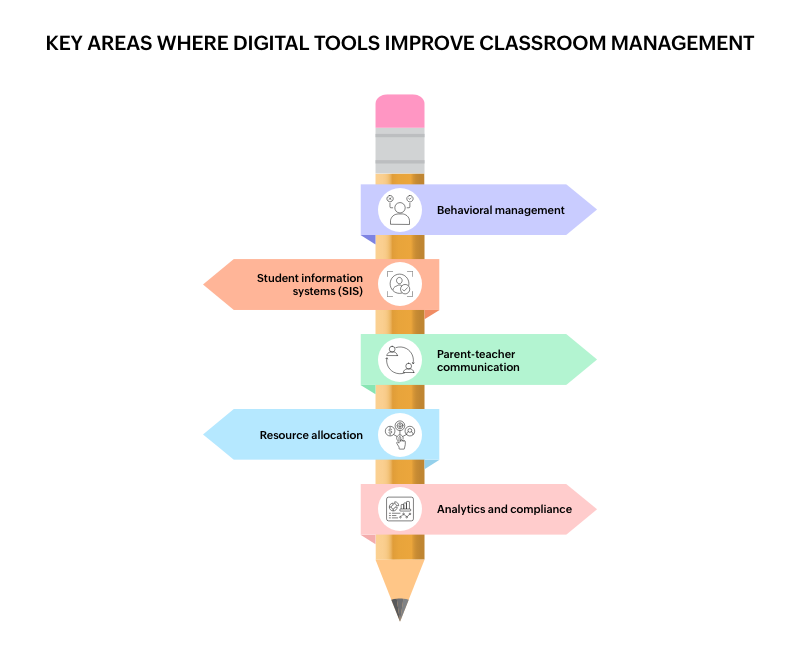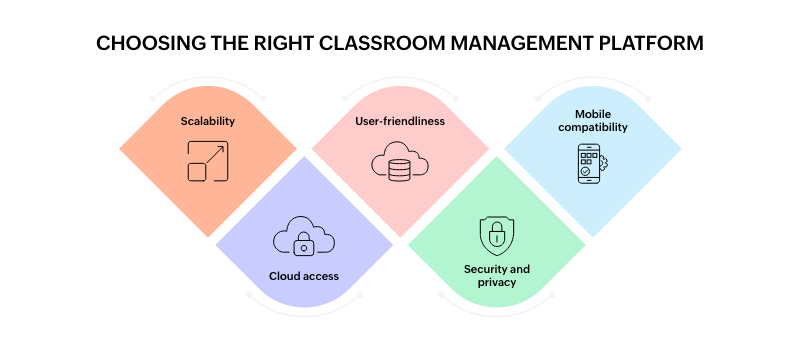- HOME
- Know Your Tech
- Why your school needs a classroom management glow up
Why your school needs a classroom management glow up
- Last Updated : July 18, 2025
- 154 Views
- 5 Min Read
I can still picture my old classroom. Sunlight streaming through dusty windows, the blackboard filled with chalk scribbles, and my teacher juggling a mountain of paperwork. Every morning, roll call was a ritual—names echoed, hands shot up, and the teacher’s pen scratched furiously across the attendance sheet. If someone misbehaved, it meant a stern look and a note—handwritten, slipped into a backpack, and often lost before it reached home. Homework was tracked in dog-eared diaries, and parents found out about our progress weeks after report cards were handed out.
Back then, classroom management was all about keeping order—organizing lessons, recording attendance, and hoping nothing slipped through the cracks. It was a world of paper, patience, and plenty of chaos. Looking back, I realize how much time my teachers spent on paperwork instead of teaching.
The evolution of classroom management
The world outside was changing, and so were the walls within. The old ways—strict discipline, rigid seating, and one-size-fits-all rules—began to fade. New ideas swept in: teachers started listening more, students collaborated, and classrooms became places of dialogue, not just discipline.
Effective classroom management stopped being about control—it became about connection. Theories shifted to student-centered approaches that emphasized emotional intelligence, engagement, and trust. Teachers learned that building relationships and encouraging self-regulation worked better than simply enforcing rules.
Then came the tech.
Learning management systems (LMS), behavior tracking apps, and student information systems (SIS) began to replace paper logs, making classrooms more responsive and inclusive. Chalkboards gave way to dashboards. Registers became attendance apps. Learning management systems replaced paper planners. Today, classroom management is about creating an environment where every student can thrive—whether they’re in the room or logging in from home.
And the numbers back it up. According to The Business Research Company, the classroom management systems market is projected to grow from $8.55 billion in 2024 to $10.64 billion in 2025, at a CAGR of 24.5%. Driving this surge is the increasing demand for hybrid learning, government digital education initiatives, and real-time classroom visibility.
Supporting this trend, Future Market Insights reports that the cloud services market is seeing rapid growth, as schools and institutions prioritize flexibility, scalability, and always-on access to data—key advantages of cloud-based classroom management platforms.
Going from chalkboards to dashboards
Modern classrooms have embraced digital transformation, and it shows. Behind the scenes, a complex set of tools and workflows support the daily routines that once depended entirely on memory and manual effort. Let’s explore how digital tools are improving classroom management across key areas:

Behavioral management
Tracking student behavior is more nuanced today. Teachers can log incidents digitally, set up automated alerts for repeated disruptions, and track positive behavior over time. Encouraging students through reward systems has become an essential part of building a supportive learning environment.
For example, if a student regularly meets classroom rules or helps others during group work, they can earn recognition points or digital badges. These strategies help reduce classroom management issues and promote accountability.
Student information systems (SIS)
Gone are the days of bulky admissions files and scattered academic records. SIS platforms centralize everything—from enrollment and fee status to academic performance and disciplinary history. Teachers and administrators can access comprehensive student profiles at any time, enabling early intervention and better decision-making.
Attendance and performance tracking
With digital dashboards, taking attendance no longer interrupts class flow. Smart apps auto-mark attendance, send alerts for repeated absences, and flag potential off-task behavior. Teachers can also monitor performance trends, identify learning gaps, and customize support for struggling students.
Parent-teacher communication
One of the most transformative shifts in classroom management has been in how schools interact with families. Parents today expect regular updates—not just during report card season. Platforms now allow teachers to share instant feedback, photos of student work, or even casual notes celebrating improvement.
This kind of regularly consistent interaction helps parents stay involved and gives students a deeper sense of accountability.
Resource allocation
Behind the scenes, school admins juggle classroom schedules, staff rotations, and equipment distribution. Digital tools make this seamless—automated calendars, classroom usage stats, and faculty assignment logs reduce errors and save time.
Analytics and compliance
Modern classroom tools offer real-time data analytics, making it easier to track outcomes and comply with regulations. Whether it's preparing for audits or presenting performance metrics to stakeholders, schools can now do it with the click of a button.
Why smarter tools—and smarter strategies—matter
Not every school operates the same way. A cookie-cutter solution might solve basic problems, but it often fails to account for the diversity in school processes. That’s why many educators now seek classroom management software that’s modular, flexible, and customizable.
A school may want to automate attendance but keep its existing grading system, or create a custom app for managing extracurricular activities. In cases like these, low-code platforms offer the perfect middle ground—no need for a full IT team, but complete control over what you build.
Why low-code hits the sweet spot between IT and education
What is low-code? It’s a development approach that allows users to build applications using visual interfaces and minimal hand-coding. For schools, this means teachers and admins can create solutions tailored to their unique workflows—without needing a programming degree.
With platforms like Zoho Creator, schools can:
- Build custom apps for attendance tracking, grading, or communication workflows
- Automate repetitive tasks like sending absence alerts or collecting homework
- Integrate smoothly with existing tools—like accounting software, LMS platforms, or chat systems
- Adjust workflows based on real-time feedback from staff or students
And now, with generative AI built in to many low-code platforms, schools can go even further. Educators can describe what they need in plain language and let AI generate the first version of the app, form, or report. This dramatically speeds up development and lowers the barrier for non-technical users. Whether it’s generating automated grading logic or suggesting smarter workflows, AI becomes a creative assistant in the classroom management process.
How a prominent Chennai-based college transformed their classrooms using Zoho Creator
New Care College is a great example of what’s possible when digital transformation is done right. Using Zoho Creator, they developed a comprehensive classroom management system that:
- Consolidated behavior tracking, attendance, and communication in one place
- Improved transparency for parents
- Freed up teachers to focus on what matters—teaching
The result? A school environment where students felt more supported, teachers were less overwhelmed, and administration ran like clockwork.
Choosing the right classroom management platform
If you're exploring digital tools for your school, here are some key classroom management features to keep in mind when evaluating platforms:

Scalability: Will it grow with your school and support hybrid or remote learning models?
Cloud access: Can it be used from anywhere—home, campus, or during school trips?
User-friendliness: Is it easy to use for teachers with limited tech experience?
Security and privacy: Are there role-based access controls to protect sensitive data?
Mobile compatibility: Can you manage things on the go?
A great platform not only fits your needs today—it evolves with you.
The way forward
Classroom management has come a long way from chalkboards and detention slips. Today, it's at the heart of effective teaching—supporting everything from student learning and engagement to administration and compliance.
With digital tools, teachers can spend more time engaging students and less time on paperwork. Students benefit from structured environments that support their individual growth, and parents become true partners in their children’s education.
As schools embrace digital transformation, low-code platforms like Zoho Creator will play a central role in helping institutions build, iterate, and improve on their own terms—no tech department required.
 Stephen
StephenStephen is a product marketer at Zoho Creator. An avid writer, he plies his trade evangelizing low-code during the day and pens songs at night. Sneakerhead and sushi enthusiast too.



